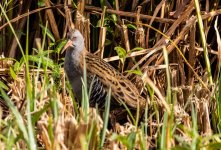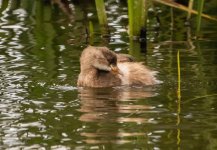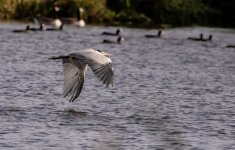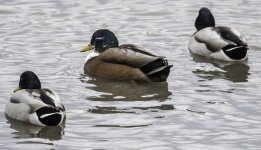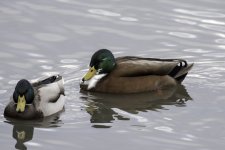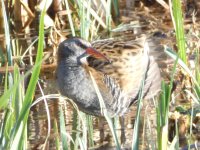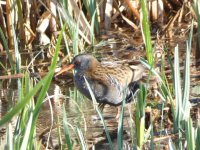-
Welcome to BirdForum, the internet's largest birding community with thousands of members from all over the world. The forums are dedicated to wild birds, birding, binoculars and equipment and all that goes with it.
Please register for an account to take part in the discussions in the forum, post your pictures in the gallery and more.
You are using an out of date browser. It may not display this or other websites correctly.
You should upgrade or use an alternative browser.
You should upgrade or use an alternative browser.
Upton Warren (20 Viewers)
- Thread starter andythomas
- Start date
More options
Who Replied?Steve Newland
Well-known member

A quiet afternoon at the Flashes until an egret flew in from the north at 14:27. Obviously little but I just happened to be on the binoculars and then picked up its big yellow bill and the sheer size of the bird. The great white circled down, stayed for a minute, lost interest and flew off southwest. Where from, where to? Who can say.
John Sirrett
Well-known member
MJI and I were happily chatting in the flashes hide today at five to 4pm today (13/10) began a slow walk back then a sudden 'they shut the gates at 4pm' run - oh how we laughed! No panic at the gates and we left about 8 minutes passed 4pm. But not recommended.Please note that from 1st October the Flashes has moved to its winter closing time with the Sailing Centre car park shutting at 4pm. With no pedestrian gate now access is not possible after this time (presently 2.5 hours before dusk....)
Upton highlights: 3 Avocets 2Jack Snipe (one from each hide) 52Shoveler 49 Moorhen 26Teal on flashes and on the Moors 10Gadwall and an Otter.
Phil Andrews
It's only Rock and Roller but I like it

More sad news with the passing of regular Upton Warren photographer Chris Cook.
Steve Newland
Well-known member

The avocets were back down to one at the Flashes with no other changes. Someone keeps reporting green sandpipers there but I don't see them. However, one common sandpiper did fly across the sailing pool as I walked in.
John Sirrett
Well-known member
Regarding the other two Avocets although it is late in the year conditions have been mild. I have frequently sound recorded Avocets moving about at night here in Solihull in spring and autumn. They are much more mobile than you might imagine. But as to the origin of these particular two birds seen last week well that could be anywhere they are a widespread European & Central Asian species wintering as far south as South Africa and south Asia . Avocets are a breeding species (obviously) with 1950 UK pairs in 2013-2017 - but they are also partially UK resident as well as a short and long distance passage migrant and a non breeding winter migrant to the UK with 8700 wintering individuals 2012-2017 Newton 2010 & BTO Birdfacts. I note from the BTO site that three Avocets ringed in Worcestershire (presumably at Upton Warren) have been recovered but can not recall nor find any details - perhaps Phil has the information.Ohh John you have the 2000th page post - surely a milestone
Where do we think the other 2 avocets have come from so late in the year?
John Sirrett
Well-known member
MJI and I saw two Rock Pipits in between the second and third flash yesterday (Wed 20/10) at around 2 o'clock which were flushed by either the male Sparrowhawk that shot through or the male Kestrel which started to hover over the back of the second flash at the same time. The two rock pipits flew off calling over the main hide and were not seen to return: so it seems unlikely they made up part of the flock of three birds seen later in the afternoon in the 'Curlew' scrub in front of the main hide. So my money is on five Rock Pipits being seen.
Also on the Flashes, one Avocet remained, one Lapwing remaining (following Peregrine flush), one Green Sand and 10 Curlew. Teal 73, Coot 28, Shoveler 1, Meadow Pipit 7-8.
On the Moors late in the afternoon a female/ immature Goosander dropped in, and there were 4 Little Egrets, (Pintails were reported but I did not see any). I thought that I heard a Whooper Swan above the East Hide but all I could see was a large flock of Canada Geese spiralling down to roost. As I was leaving a murmuration of c150 Starling were forming over the reedbed and I got a message from Mike Wakeman that a Whooper Swan had dropped into the Flashes.
Also on the Flashes, one Avocet remained, one Lapwing remaining (following Peregrine flush), one Green Sand and 10 Curlew. Teal 73, Coot 28, Shoveler 1, Meadow Pipit 7-8.
On the Moors late in the afternoon a female/ immature Goosander dropped in, and there were 4 Little Egrets, (Pintails were reported but I did not see any). I thought that I heard a Whooper Swan above the East Hide but all I could see was a large flock of Canada Geese spiralling down to roost. As I was leaving a murmuration of c150 Starling were forming over the reedbed and I got a message from Mike Wakeman that a Whooper Swan had dropped into the Flashes.
Phil Andrews
It's only Rock and Roller but I like it

No Avocets young have been ringed at UW but several birds ringed elsewhere have been recorded, most notably "white 64" which returned for several years.Regarding the other two Avocets although it is late in the year conditions have been mild. I have frequently sound recorded Avocets moving about at night here in Solihull in spring and autumn. They are much more mobile than you might imagine. But as to the origin of these particular two birds seen last week well that could be anywhere they are a widespread European & Central Asian species wintering as far south as South Africa and south Asia . Avocets are a breeding species (obviously) with 1950 UK pairs in 2013-2017 - but they are also partially UK resident as well as a short and long distance passage migrant and a non breeding winter migrant to the UK with 8700 wintering individuals 2012-2017 Newton 2010 & BTO Birdfacts. I note from the BTO site that three Avocets ringed in Worcestershire (presumably at Upton Warren) have been recovered but can not recall nor find any details - perhaps Phil has the information.
Phil Andrews
It's only Rock and Roller but I like it

John - the three ringed Avovet recorded at Upton Warren are as follows:No Avocets young have been ringed at UW but several birds ringed elsewhere have been recorded, most notably "white 64" which returned for several years.
Yellow flag "D3" - seen at Upton on 11th May 2019. Ringed at Nosterfield, North Yorkshire on the 16th June 2018 and also seen at Alkborough Flats, Lincs and Goldcliffe, Gwent.
White ring "64" - seen on various dates between 2014 and 2018. Ringed at Zwarte Hann in the Netherlands on the 4th September 2008. Also noted at Blacktoft Sands (East Yorkshire), Halsham (East Yorkshire), Clifton Pits (Worcs) and Lower Moor (Worcs).
A combination of colour rings (white over blue / white over black) - seen on the 10th and 11th September 2017. Ringed at Seal Sands Cleveland on the 6th July 2017. Further recorded at Blacktoft Sands (East Yorkshire), Burton Mere (Cheshire), Mistley (Essex) and East Tilbury (Essex).
John Sirrett
Well-known member
Well they do move about don't they. It makes it quite difficult to interpret the birds I record at night flying over Monkspath, Solihull. I thought some of those this year (2021) might be local movements between Marsh Lane and Earlswood as a pair were moving between the sites apparently at night. But who can say given the range of movements evidenced by the ringers. It follows that the birds Julie was enquiring about could be local birds, passage migrants or even winter visitors. Regards, JohnJohn - the three ringed Avovet recorded at Upton Warren are as follows:
Yellow flag "D3" - seen at Upton on 11th May 2019. Ringed at Nosterfield, North Yorkshire on the 16th June 2018 and also seen at Alkborough Flats, Lincs and Goldcliffe, Gwent.
White ring "64" - seen on various dates between 2014 and 2018. Ringed at Zwarte Hann in the Netherlands on the 4th September 2008. Also noted at Blacktoft Sands (East Yorkshire), Halsham (East Yorkshire), Clifton Pits (Worcs) and Lower Moor (Worcs).
A combination of colour rings (white over blue / white over black) - seen on the 10th and 11th September 2017. Ringed at Seal Sands Cleveland on the 6th July 2017. Further recorded at Blacktoft Sands (East Yorkshire), Burton Mere (Cheshire), Mistley (Essex) and East Tilbury (Essex).
Phil Andrews
It's only Rock and Roller but I like it

Nice captures Susianna - was that from the concrete hide?
Yes it was!Nice captures Susianna - was that from the concrete hide?
Steve Newland
Well-known member

A very quiet Flashes couldn't even disclose the avocet this lunchtime. By contrast the Moors was dripping. A lone pintail was by a lone wigeon, both only visible from the Jacobs Hide. Eventually the shelduck hove into view. Many Cetti's called and one even showed, with its rufous tail. One water rail popped out briefly. At the back of the hide a huge flock of linnets also held chaffinches and greenfinches - nothing more exotic though. Intermittent redwings passed with one fieldfare. While I was watching all this, only my second treecreeper for the reserve foraged about ten feet away and a green woodpecker bounded past.
On my way to the east of the pool I scanned for a calling bullfinch but found a blackcap instead! As I was about to leave the hide over there, I heard a curlew and wondered where it was. Turned out ten had just dropped in right in front of me. The finale was a kestrel hunting by the rheas (I'm not counting them!)
On my way to the east of the pool I scanned for a calling bullfinch but found a blackcap instead! As I was about to leave the hide over there, I heard a curlew and wondered where it was. Turned out ten had just dropped in right in front of me. The finale was a kestrel hunting by the rheas (I'm not counting them!)
Steve Newland
Well-known member

The barnacle goose had disappeared beyond the transmitters by the time I got to the Flashes and there was precious little else apart from one snipe. On the way in, six little egrets were unusual in trees at the northwest of the sailing pool.
Again, the Moors was better and I finally found a female brambling in the linnet flock for my first reserve record. The redwings held one mistle thrush and a male kingfisher showed nicely right in front of the Jacobs Hide. Round the back of the East Hide a flock of long-tailed tits also included a goldcrest and a redpoll - eight years since my last record at the site.
Again, the Moors was better and I finally found a female brambling in the linnet flock for my first reserve record. The redwings held one mistle thrush and a male kingfisher showed nicely right in front of the Jacobs Hide. Round the back of the East Hide a flock of long-tailed tits also included a goldcrest and a redpoll - eight years since my last record at the site.
wheatearlp
Well-known member

For anyone hoping for Brambling, or better, amongst the finches & buntings in the game crop field between the A38 & Moors Pool, please remember THE FIELD IS NOT PART OF THE RESERVE. Therefore, please stick to the west track or Salwarpe path when searching.
Similar threads
- Replies
- 1
- Views
- 1K
Users who are viewing this thread
Total: 21 (members: 4, guests: 17)




